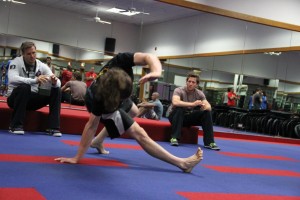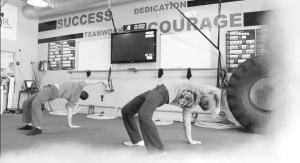The Flow Seminar is a very cool bodyweight training course put together by two of the top people in the field.
While so much of bodyweight training to many people is about counting reps, one of the directions more and more people are moving in, is in using it for one of its biggest strengths…
That is the complexity of movements, especially done together in flow. This doesn’t just get people stronger but teaches them MOVE much better, giving them some great “show-off” moves along the way.
Ryan Hurst of GMB is one of the two. I’ve been recommending his programs for years as they’re some of the best out there, in structure, technical detail, and in the results they deliver.
Mike Fitch of Global Bodyweight Training is the other, and a guy I’ve spent a fair amount of time on the phone with. He is the creator of Animal Flow, something that truly revolutionized how “animal movements” have been done.

At an Animal Flow Workshop with Mike Fitch looking as I do an Under Switch
So when these two got together it was no surprise that something awesome came out of it.
There is a Problem with Flow…
It’s tough to do in the beginning just by yourself trying things out.
Although it might seem antithetical to have a pre-planned flow, this is really the best starting place to get different movements into your body as well as understanding the transitions between them.
If you don’t have the components down, you have no chance of smoothly flowing them together.
Here’s a list of the four flows, in The Flow Seminar, and the “five” movements that make up each.
Squat Flow
- Pistol Squat
- Leg Switch
- Scorpion Sweep
- Dragon Squat Twist
- Spin into Deep Lunge and Stand from Shrimp Squat
 Push Flow
Push Flow
- Lunge Press and Sit Back
- Turn Over into Beast Crouch
- Underswitch to Bridge Reach Back
- Turn Over into Double Arm Lever
- Leg Switch and Propel into Squat then Stand Up
Pull Flow
- Squat into Box Sit
- Crane Leg Switch
- Short V-Sit
- Drop and Roll
- Pull Feet Towards Hands and Stand Up
Aerial Flow
- Butterfly Kick
- Cartwheel
- Frogger Jump into Handstand
- Snake Down
- Pop Up into Squat then Stand Up
Honestly, if you get these four flows done you will be at a point where you can certainly make up your own.
For the tougher movements in the flow, one or more regressions are shown. They also give examples of making these flows tougher (seeing Ryan’s control of the press handstands in the Pull Flow made me jealous…)
What I Really Liked…
I got an advanced copy of the course to review and I was very pleased with the quality of what’s inside the less than 3 hours of video. Let me take you inside and share a couple things that really stood out to me:
- A very cool wrist, elbow and finger warmup
- I’ve been doing pistols for years. But I learned some awesome little tips and tricks from Ryan and Mike in this section that had everyone at the seminar doing pistols in minutes. I’m kind of jealous I didn’t come up with those ideas.
- Best instruction I’ve ever seen on how to do the Butterfly Kick.
- How and when to best use momentum in several movements
- Some useful training drills to build up to the harder movements
Who is this for?
If you’re just starting out exercising this probably isn’t right for you. For best results you’d want a couple years of training under your belt with at least some of it being bodyweight movements.
On the flip side, if you’re looking at that list of movements, each one looks easy, and you can see how they flow together in your mind’s eye, then you probably don’t need this course.
But if you are somewhere in the middle I think this is worth your consideration.
Even if some of the movements seem out of your range (like the pistol for instance) you might be surprised at what you’ll pull off when you get to that part of the flow.
If you’ve never really worked with flowing movement like this before you need this. The combination of movement, mobility and coordination, is likely something you might not be getting so much from your other training.
When you get The Flow Seminar I recommend watching it in an open area so you can follow along.
Start with the squat flow, probably the easiest one as they progressively get tougher, work on it, and when you’re ready move on.

Comments
When and where is the next seminar?